Nexus
The Jupiter Incident
By
Niloy
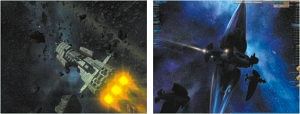 Space.
There is, to put it mildly, rather a lot of it. It's vast, dark and
cold beyond imagination, and filled only with emptiness. And lens
flare, naturally.
Space.
There is, to put it mildly, rather a lot of it. It's vast, dark and
cold beyond imagination, and filled only with emptiness. And lens
flare, naturally.
Space is, quite
frankly, a bit of a tough sell as real estate goes, but it's certainly
very good for certain things - such as playing host to epic battles
between hulking metallic capital ships, darting fighters and sleek
alien starfaring vessels, all tearing strips off each other with exotic
combinations of beam weapons, mass drivers and lethal torpedoes.
It's a good thing,
then, that Mithis, the developer, decided to add the space battling
element to Nexus - The Jupiter Incident, since a game focused on looking
at nicely rendered asteroids, planets and, er, hard vacuum, wouldn't
be very entertaining. Instead, they've delivered a game which is a
science fiction fan's dream - filled with the epic battles, hulking
capital ships and what have you, and presented with a sense of dramatic
scale that leaves other space strategy games in the moondust.
Nexus is, in short,
a space strategy simulation. Nexus is all about commanding a battleship
or a small fleet through engagements with the enemy and other such
missions. Rather than just clicking on a point on the map and telling
a unit to head over there and mine some ore or shoot some bad guys,
you're effectively placed in the captain's chair, and must command
the ship(s) and crew on a much more up close and personal level.
The types of battles
you'll be fighting in Nexus are quite different to those found in
the vast bulk of space warfare games. Mithis are from a school of
science fiction game design which sees capital ships as great lumbering
beasts which manoeuvre around each other in combat, struggling for
the best shooting positions, while smaller fighter craft dash around
in the spaces between the ships almost too fast to see. In fact, this
is more like naval combat than like any space combat you may have
seen before, as the lumbering ships circle each other and turrets
track their targets, each captain seeking to inflict the crucial blow
of the battle.
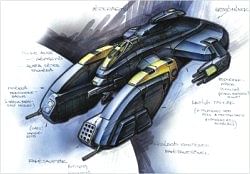 The
range of control available to you might seem slightly odd atfirst
to those unused to this style of game - which, let's face it, will
be most people. Your control over the ships you command generally
doesn't give you second by second input into where the ship is steered,
for example - that's largely left up to the crew. However, not only
can you select which enemy craft to target, but you can also select
individual sub-systems on the ship to attack, thus allowing you to
disable a ship's systems rather than just pounding at its hull - or,
if you're feeling nasty, to disable its systems and then pound at
the hull anyway. You can also choose to launch your fighters, and
despatch them to meet threats from enemy squadrons or just to harass
a bigger ship while you move your capital ship in for the kill, and
can even launch transports of marines to board crippled enemy vessels.
The
range of control available to you might seem slightly odd atfirst
to those unused to this style of game - which, let's face it, will
be most people. Your control over the ships you command generally
doesn't give you second by second input into where the ship is steered,
for example - that's largely left up to the crew. However, not only
can you select which enemy craft to target, but you can also select
individual sub-systems on the ship to attack, thus allowing you to
disable a ship's systems rather than just pounding at its hull - or,
if you're feeling nasty, to disable its systems and then pound at
the hull anyway. You can also choose to launch your fighters, and
despatch them to meet threats from enemy squadrons or just to harass
a bigger ship while you move your capital ship in for the kill, and
can even launch transports of marines to board crippled enemy vessels.
The whole affair
is superbly presented from a user interface perspective. The control
system for the game is logical and clear, with a fairly simple set
of buttons arranged around the edges of the screen, leaving you free
to view the action and move your viewpoint around in the middle. Helpfully,
you can select units - both friendly and enemy - from lists on either
side of the screen, and just about everything that needs to be done
can be done from the clear menu system. It's an interface that any
strategy game player will get used to very quickly, and the game does
an excellent job of gently guiding you through the first few missions
to get you accustomed to it anyway.
The problem with
the control system - and this is more a function of the basic gameplay
than of the user interface - is that you rarely actually feel in-control
of the events unfolding in front of you. Certainly, your actions have
a major impact on the battle, but the immediate effect of issuing
orders and changing tactics is often frustratingly indescribable.
This is perhaps a feature of this type of game, rather than a flaw
with Nexus in particular, but it can be very annoying even for the
seasoned strategy gamer. The game is also, quite frankly, slow. You'll
spend ages watching capital ships circle as they wear down each other's
health.
One of the most
impressive things about Nexus is the 3D graphics engine that Mithis
has assembled for the game, and suffice it to say that the eye-candy
is very gorgeous. Perhaps best described as "Doom 3 in space,"
the engine throws around intricately modelled and bump mapped ships
with realistic shadows moving over their surfaces, countless projectiles
and asteroids, detailed space stations and stunning particle and weapon
effects which combine to make it into one of the best-looking space
games ever to grace a PC. The excellent technology isn't let down
by the quality of the artwork, either. Human and alien spacecraft
are fairly varied and interesting, and uniformly well designed and
detailed - although one can wonder whether the frequent resemblances
to spacecraft from various other science fiction universes is homage,
or rip-off.
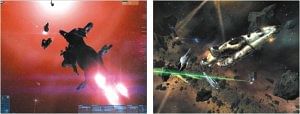 The
plotline itself is fairly unremarkable, covering territory to do with
the use of alien technology by a shadowy syndicate in Earth's solar
system, the wormhole your father's spaceship disappeared through when
you were still a child, and other such Shocking Revelations. Perhaps
I'm just jaded by too much science fiction, but it all seemed terribly
predictable, although it's expertly written stuff which acceptably
fills a gap between majestic space battles.
The
plotline itself is fairly unremarkable, covering territory to do with
the use of alien technology by a shadowy syndicate in Earth's solar
system, the wormhole your father's spaceship disappeared through when
you were still a child, and other such Shocking Revelations. Perhaps
I'm just jaded by too much science fiction, but it all seemed terribly
predictable, although it's expertly written stuff which acceptably
fills a gap between majestic space battles.
Despite
its unquestionably high production values, excellent graphics and
keenly realised battle simulations, Nexus feels like a little bit
of a disappointment. The first couple of hours of the game are fantastic,
as you're introduced to the universe, the ships, the stunning battles
and the interesting gameplay, but for the average strategy fan, the
realisation that the game is all about increasingly complex micro-management
of your ships and crew is something of a let-down.
Fish
Diversity Tied to Evolution of Diving Ability
By
Sarah Graham
 From
clownfish to catfish, grouper to great white, the diversity of fish
in the sea is nothing short of astonishing. Now scientists have managed
to account for this wide assortment, at least in part, by tracing
the evolution of the organ that allows the creatures to swim at different
depths.
From
clownfish to catfish, grouper to great white, the diversity of fish
in the sea is nothing short of astonishing. Now scientists have managed
to account for this wide assortment, at least in part, by tracing
the evolution of the organ that allows the creatures to swim at different
depths.
To change
their buoyancy and move up and down in the water, fish inflate an
internal organ called the swim bladder. Some fish, such as herring,
must surface and gulp air in order to fill their swim bladders with
oxygen. Other fish, which are able to submerge for much longer periods
and thus reach greater depths, are able to use oxygen from their blood
in order to inflate the swim bladder, thanks to a specific type of
protein known as Root-effect hemoglobin.
Michael
Berenbrink of the University of Liverpool and his colleagues traced
the evolution of this protein in a variety of species, from sharks
to dolphinfish, and found that it evolved just once. The emergence
of the protein then allowed for the formation of a complex network
of veins and arteries, called the rete mirabile, which supported the
creatures' retinas and allowed the fish to see better. The rete mirabile
also appears to have evolved only once, about 250 million years ago.
The capillaries that support the swim bladder and allow oxygen to
be delivered to it appeared about 100 million years later.
The swim
bladder itself, however, arose independently in four different fish
groups, Berenbrink and his collaborators report in the current issue
of the journal Science. The team proposes that the evolution of the
swim bladder accounts for part of the huge diversity of form and function
in living fishes. For example, there are 198 species of Mormyroidea
fish, all of which have swim bladders, yet there are only eight species
of their close relatives, the Notopteridae, which lack the complex
organ.
 26
Episodes.
26
Episodes.
Generally,
a game-to-anime translation isn't something to look forward to. More
often than not, they turn out to be rather woefully disappointing.
Generally.
Gungrave
happens to break the mold, and shatter it into a million bits in the
process. The Playstation 2 game was a no-brainer shoot-anything-that-moves
which made no sense by the time you got to the end of it; the anime
is one of the most spectacularly riveting stories of lifelong friends
turning enemies in a Mafia power struggle that'd do justice to the
Godfather. Gungrave isn't about power-play in a crime syndicate, though
that is what shapes and drives both the protagonist (Brandon Heat)
and the antagonist (Harry Macdowell) into the people they become;
the real story is about trust, and betrayal, and protecting those
that one loves.
Every
character created in the series is painstakingly detailed, and utterly
believable till the end; they develop considerably, and grow in stature
with the passage of time. Brandon grows from an introverted thug to
a confident upper echelon mobster, and every instant of this evolution
is natural; likewise, Harry's fall from grace is executed to perfection.
As they climb the ranks of the organization, new components of the
syndicate's hierarchy are exposed; each of these then proceed to roles
that are eminently necessary by the way the plot unfolds.
The latter
half of the series has less to do with the mafia, and indeed takes
some getting used to; resurrections from the dead, and bizarre supernatural
metamorphoses are rampant; however, these do not detract from the
telling, and the story ends in one of the most powerfully moving ways
one would have thought.
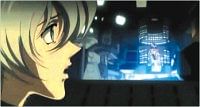 Beside
such a plot, the technical details seem trivial; nevertheless, Gungrave
continues to shine. The voice-acting is superb in the original Japanese,
the music fitting (indeed, every track literally screams "I am
the music of Gungrave!" at the listener afterwards). The artwork
is quite stellar; characters visibly age, are drawn with a vivid visual
style that is, while not very distinctive, extremely confident. Animation
is naturally fluid, and the action sequences are choreographed to
be most satisfactorily impressive and intense.
Beside
such a plot, the technical details seem trivial; nevertheless, Gungrave
continues to shine. The voice-acting is superb in the original Japanese,
the music fitting (indeed, every track literally screams "I am
the music of Gungrave!" at the listener afterwards). The artwork
is quite stellar; characters visibly age, are drawn with a vivid visual
style that is, while not very distinctive, extremely confident. Animation
is naturally fluid, and the action sequences are choreographed to
be most satisfactorily impressive and intense.
If
there is to be a gripe, at all, one would say that the first episode
fails to work; indeed, it is the single worst episode in the series.
It feels abrupt, but once one gets past that, Gungrave is a true gem,
and well deserving of being on anyone's must-see list.
By
Lancer
Minority Report
By
Gokhra
 This
was a movie I waited to watch until a good print showed up. Its shot
in shades of blue that looks horrible in a cinema print. It's also
a movie that you can safely add to your DVD collection cause its that
good.
This
was a movie I waited to watch until a good print showed up. Its shot
in shades of blue that looks horrible in a cinema print. It's also
a movie that you can safely add to your DVD collection cause its that
good.
The
plot: Set about twenty years down the line it deals with the life
and adventures of a cop John Anderton (Tom Cruise) who stops crime
before it even happens by a complicated method of seeing into the
future. John is a drug-using cop who lost his little son to a kidnapper.
Following that incident a new method of stopping crime was devised
and he pretty much dedicated his life as a crime fighter.
The
looking into the future bit carried out by a trio of people who were
born with some genetic differences. Every time they slept they would
dream of horrible murders happening which people later found out were
actually happening in real life. This psychic trio become the Precogs
who were kept lying in a liquid filed pool attached to computers that
would allow their drams to be interpreted onto display units. The
Precogs could see crimes happening before it actually happened John
would lead the task force that would swing into action arresting the
soon to be criminals. These people were then put away for good. As
a result, crime rate was at an all time low.
So
everything is going fine until (Collin Farrell) shows up investigating
the organization to see if all is actually all that good. I guess
nothing is too good to be true. Somewhere along the course of the
investigation a new image turns up showing Tom killing someone. He
runs because he is about to be put away like the rest but he believes
he is innocent.
In
this process there are lots of chases with jet packs up and down and
even through buildings. One of the chases end in an automated car
factory where John stumble on an assembly line and has an entire car
built around him in a few minutes. That he uses to drive away much
to the chagrin of his pursuers.
John
does manage to get to the man who he is supposed to be killed. That
man seems to be the person responsible for the disappearance of his
child which is a pretty good reason for John to kill. But then h realizes
that there is a choice to be made. And the doubt of the doubtless
crime fighting method creeps in that maybe some of the people captured
would have made different choices. Of course John does shoot the man
albeit accidentally fulfilling the prophecy. But by ten we figure
it's a frame-up. The question is who, why and how.
The
way the answer is led up to is not at all disappointing despite the
fact that occasionally you will find plot holes big enough to put
a fist through. It's a suspenseful thriller that thrills.
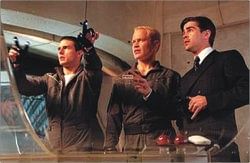 The
verdict: You have to watch the movie carefully because the plot twists
and jumps suddenly. The action is good and a times unique even though
it's disappointing to find out that the world of the future only has
Lexus cars.
The
verdict: You have to watch the movie carefully because the plot twists
and jumps suddenly. The action is good and a times unique even though
it's disappointing to find out that the world of the future only has
Lexus cars.
There
are bits of humor although rare and some more would have definitely
helped. There's a scene where Tom is running after an eyeball that
he disgustingly dropped. He needs it to open a retinal scan activated
doorway.
The
eyeball drops into a drain but he catches it not a moment too soon.
The movie keeps you running a dizzying gamut of clues, hints, traps
and dead-ends in Johns hunt for the truth. Steven Spielberg created
a stylish, tricky and irresistible whodunnit
The
movie is not just good it is damn brilliant.
